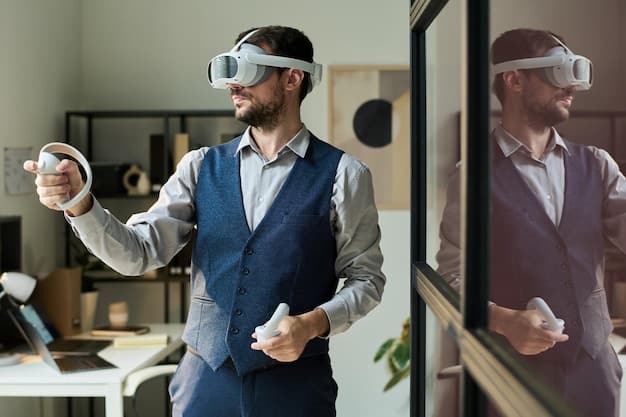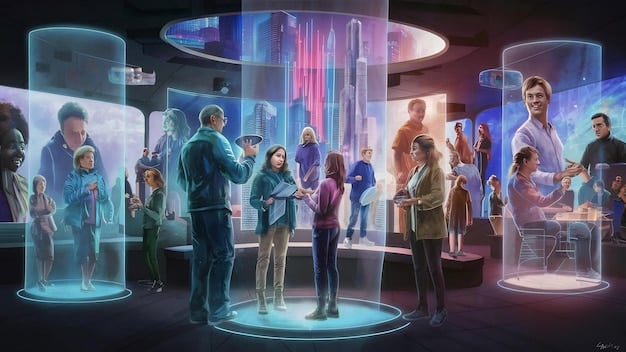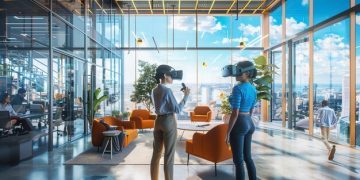US Businesses & Metaverse Workplace: Are You Ready?

The metaverse workplace promises to revolutionize US businesses by transforming remote collaboration, employee training, and customer engagement through immersive digital environments.
As the digital landscape evolves at an unprecedented pace, a new frontier beckons US businesses: the metaverse workplace. This immersive digital realm is not merely a theoretical concept but a burgeoning reality reshaping how companies operate, connect, and innovate. Understanding its potential and preparing for its integration is crucial for maintaining a competitive edge in an increasingly virtual economy.
Understanding the Metaverse Workplace Paradigm
The metaverse workplace represents a significant leap beyond conventional remote work setups, moving past simple video conferencing to fully immersive virtual environments. This paradigm shift offers a persistent, interconnected digital space where employees, regardless of their geographical location, can collaborate, learn, and socialize as if they were physically present. It taps into the very human desire for richer interaction, attempting to bridge the sensory gap left by traditional digital communication tools.
This evolving concept is not just about fancy graphics but about creating an intuitive, interactive ecosystem. Companies like Meta (formerly Facebook) with Horizon Workrooms and Microsoft with Mesh for Teams are pioneering platforms designed to facilitate these experiences. They offer virtual meeting rooms, digital whiteboards, and customizable avatars, all aimed at enhancing engagement and productivity. The underlying goal is to replicate and often augment the benefits of in-person collaboration, fostering a stronger sense of team cohesion and shared purpose within a digital sphere.
Defining Characteristics of the Metaverse Workplace
The core elements that define a metaverse workplace distinguish it from existing digital tools. These characteristics collectively aim to build a more engaging and effective virtual work model.
- Immersive Environments: Users interact within 3D virtual spaces, offering a sense of presence not possible with 2D interfaces. This includes realistic or stylized digital twins of physical offices.
- Persistent Presence: Unlike temporary video calls, metaverse environments often persist, allowing for ongoing projects, shared digital assets, and continuous collaboration.
- Interoperability: The long-term vision includes the ability to seamlessly move assets, avatars, and even experiences between different metaverse platforms, though this is still in early stages.
- Digital Avatars: Users are represented by customizable avatars, which provide a visual identity and enable non-verbal communication, such as gestures and expressions.
The shift towards this new work model is fueled by the desire to overcome the limitations of current remote work. While flexible work arrangements offer numerous benefits, fostering a strong company culture and seamless spontaneous collaboration can be challenging. The metaverse workplace seeks to address these issues by providing a more natural and engaging environment for interaction.
As businesses in the US contemplate this transformation, it’s crucial to look beyond the initial hype and understand the foundational technologies and psychological impacts. It’s about leveraging virtual reality (VR) and augmented reality (AR) to create more meaningful connections and functional workspaces, ultimately aimed at boosting efficiency, fostering innovation, and enhancing employee well-being in a distributed workforce. The success of this transition hinges on strategic planning and a clear understanding of both its promises and its challenges.
The Evolution of Remote Work and the Metaverse Promise
The global pandemic undeniably accelerated the adoption of remote work, forcing businesses to adapt rapidly to virtual operations. While many companies initially viewed this as a temporary measure, the benefits—such as increased flexibility, expanded talent pools, and reduced overheads—have solidified remote work as a permanent fixture for many. However, accompanying these benefits are challenges, including feelings of isolation, communication breakdowns, and difficulties in fostering a cohesive company culture remotely. The metaverse enters this landscape as a potential solution, promising to evolve remote work from merely functional to truly transformational.
The promise of the metaverse lies in its ability to recreate and enhance the very human elements often lost in traditional remote settings. Imagine impromptu water cooler conversations, collaborative brainstorming sessions around a virtual whiteboard, or even team-building events in a digital park—all accessible to employees anywhere in the world. This level of immersion could significantly reduce the “Zoom fatigue” prevalent in current remote work models, injecting a new dynamism into daily operations. For US businesses, this means not just maintaining productivity, but potentially soaring to new levels of creativity and employee satisfaction.
Bridging the Gap: From 2D to 3D Collaboration
The fundamental distinction between current remote work tools and the metaverse is the leap from 2D to 3D interactivity. This has profound implications for how teams collaborate and communicate.
- Enhanced Presence: Avatars mirroring body language and spatial audio create a stronger sense of “being there” with colleagues, reducing feelings of detachment.
- Spatial Computing: Digital objects and environments can be manipulated and shared in a way that feels natural, akin to working with physical items. This is particularly beneficial for design, engineering, and visual presentations.
- Reduced Cognitive Load: The intuitive navigation and interaction within 3D spaces can often be less mentally taxing than managing multiple tabs and screens in a 2D interface.
Early adopters are already experimenting with these capabilities. Companies are hosting internal meetings, conducting job interviews, and even onboarding new hires within virtual environments. These pioneering efforts underscore the potential for the metaverse to not just mimic physical interaction but to offer entirely new modes of engagement that are uniquely digital. For instance, complex data can be visualized as interactive 3D models, making it easier for teams to analyze and make data-driven decisions collaboratively.

The transition from a 2D to a 3D collaborative environment is not without its hurdles, from hardware requirements to the learning curve for new platforms. Yet, the potential rewards—a more engaged workforce, innovative problem-solving, and truly global, seamless collaboration—are compelling enough for US businesses to pay close attention. As technology advances and accessibility improves, the metaverse is poised to become an indispensable component of the remote work toolkit, offering a richer, more human-centric digital experience.
Key Technologies Powering the Metaverse Workplace
The metaverse workplace is not built on a single piece of technology, but rather an intricate stack of innovations working in concert. Understanding these foundational technologies is crucial for US businesses looking to invest in or even just explore this new digital frontier. At its core, the metaverse relies heavily on advancements in virtual reality (VR), augmented reality (AR), and artificial intelligence (AI), but it also incorporates elements of blockchain and enhanced networking capabilities.
Virtual Reality (VR) provides the immersive experience, enabling users to enter fully digital worlds. Devices like Meta Quest and HTC Vive transmit visual and auditory cues that trick the brain into believing it’s in a different environment, making virtual meetings or training sessions incredibly vivid. On the other hand, Augmented Reality (AR) layers digital information onto the real world, as seen with devices like Microsoft HoloLens. This can be particularly useful for tasks that require interacting with physical objects while accessing digital data simultaneously, for example, in manufacturing or field service. These two technologies form the sensory gateways to the metaverse.
AI, Blockchain, and Networking: The Unseen Backbones
Beyond visual and auditory immersion, a robust metaverse workplace relies on several other critical technological pillars that often operate behind the scenes.
- Artificial Intelligence (AI): AI drives the intelligence of non-player characters (NPCs) in simulated training scenarios, personalizes user experiences, and can even translate languages in real time during global meetings. AI algorithms also optimize the performance of virtual environments, making interactions smoother and more realistic.
- Blockchain Technology: While often associated with cryptocurrencies, blockchain is pivotal for creating secure and transparent digital ownership within the metaverse. This includes verifying ownership of virtual assets, guaranteeing secure transactions, and establishing digital identities, which are crucial for professional interactions and intellectual property rights in a virtual economy.
- High-Speed Networking (5G/6G): The sheer volume of data required to render complex 3D environments and manage real-time interactions demands ultra-low latency and high bandwidth. Technologies like 5G and the upcoming 6G are essential to ensure a seamless, lag-free experience, preventing motion sickness and enhancing overall usability.
The interoperability mentioned earlier, where digital assets and identities can move between different metaverse platforms, is heavily dependent on open standards and blockchain-based solutions. This means a corporate meeting held in one metaverse platform could potentially involve participants bringing virtual assets or avatar customizations from another, creating a more integrated and flexible digital ecosystem. This seamless transferability is key to overcoming platform lock-in and fostering a truly open metaverse.
For US businesses, understanding these technologies isn’t just about identifying trends; it’s about strategically planning infrastructure investments, talent acquisition, and development roadmaps. The convergence of these technologies promises a future workplace that is not only more connected but also more efficient, secure, and potentially more innovative than anything we’ve experienced before.
Strategic Advantages for US Businesses in the Metaverse
For US businesses, embracing the metaverse workplace offers a plethora of strategic advantages that can significantly impact their competitive standing. Beyond mere technological adoption, it provides opportunities to redefine talent acquisition, revolutionize training, and innovate in customer engagement. These strategic shifts are not just about incremental improvements but about fundamental transformations that can drive exponential growth and resilience in a dynamic global market.
One of the most compelling advantages is the expansion of the talent pool. By operating in a fully virtual environment, location becomes largely irrelevant. This means companies can recruit top talent from anywhere in the US, or even globally, without the constraints of relocation or time zones in many cases. This access to a broader, more diverse talent base can lead to increased innovation and a richer internal culture. Furthermore, the metaverse offers an engaging platform for employee onboarding and retention, potentially reducing turnover rates through novel interactive experiences that foster deeper connections to the company.
Revolutionizing Training and Development
Employee training and development stand to gain immensely from metaverse integration. Traditional methods, though effective, often lack the practical, hands-on experience that leads to true mastery. The metaverse can change this dramatically.
- Immersive Simulations: Employees can undergo highly realistic training scenarios in a safe, controlled virtual environment. This is invaluable for high-risk professions (e.g., manufacturing, healthcare) or for practicing complex customer service interactions without real-world consequences.
- Personalized Learning Paths: AI can tailor learning modules to individual employee needs and progress, offering a more efficient and effective educational experience within the metaverse.
- Global Collaboration on Projects: Teams scattered across different regions can collaborate on complex simulations, design reviews, or strategy development in real-time 3D spaces, speeding up project cycles and fostering cross-cultural understanding.
Beyond internal operations, the metaverse opens new avenues for customer engagement and product development. Imagine architects presenting 3D building models to clients for real-time virtual walkthroughs, or retailers allowing customers to virtually “try on” clothes and tour digital showrooms from the comfort of their homes. This enhanced interaction can lead to stronger customer relationships and faster product iteration cycles. For research and development teams, the metaverse can serve as a sandbox for prototyping and testing new concepts in a cost-effective, scalable manner.
The ability to create compelling, interactive brand experiences in the metaverse also represents a significant marketing advantage. Companies can host virtual events, launch digital products, and build immersive brand worlds that resonate deeply with digitally native consumers. These strategic advantages collectively paint a picture of a future where US businesses leverage the metaverse not just as a tool, but as a core pillar of their operational and growth strategies, preparing them for the demands of the 21st-century economy.
Challenges and Considerations for Implementation
While the allure of the metaverse workplace is strong, US businesses must navigate a complex array of challenges and considerations before fully embracing this paradigm shift. The implementation is not a simple plug-and-play operation; it requires significant investment, strategic planning, and a careful assessment of potential hurdles. Overlooking these challenges could lead to costly mistakes and a failure to realize the metaverse’s full potential.
One of the primary concerns revolves around initial investment costs. Implementing a metaverse workplace requires not only software licenses for platforms but also significant hardware upgrades, including VR/AR headsets and powerful computing systems for employees. Furthermore, cybersecurity and data privacy present substantial challenges. Operating in a decentralized, interconnected virtual environment introduces new vulnerabilities that must be rigorously addressed, potentially requiring advanced encryption, secure authentication, and robust data governance policies to protect sensitive company and employee information.
Overcoming Technical and Human Roadblocks
Beyond financial and security concerns, there are notable technical and human-centric hurdles that need careful consideration.
- Technical Infrastructure: Ensuring all employees have access to reliable high-speed internet and the necessary hardware can be a logistical and financial strain, especially for larger organizations or those with a widely distributed workforce.
- User Adoption and Training: Not all employees will be comfortable with virtual reality or avatar-based interactions initially. Comprehensive training programs and a supportive culture are needed to encourage adoption and overcome potential resistance or technology fatigue.
- Interoperability Standards: The lack of universal standards across different metaverse platforms can create silos, making it difficult to move assets or collaborate seamlessly if a business uses multiple systems. This fragmented ecosystem demands careful vendor selection and future-proofing strategies.

The psychological impact on employees also warrants attention. Extended periods in VR environments can lead to “VR sickness” for some individuals, and the novelty might wear off, making long-term engagement a challenge. Companies must consider how to balance immersive experiences with mental well-being, potentially incorporating breaks, varied activities, and non-VR work. Furthermore, the legal and ethical implications surrounding digital ownership, intellectual property in virtual spaces, and virtual harassment are still largely undefined, creating a potentially complex regulatory landscape that businesses must monitor and factor into their strategies.
Ultimately, a successful transition to the metaverse workplace requires a phased approach, starting with pilot programs, gathering employee feedback, and iteratively refining the strategy. It’s about understanding that the metaverse is not a destination but an ongoing evolution, demanding continuous adaptation and innovation from US businesses to leverage its benefits while mitigating its inherent risks.
Best Practices for a Seamless Metaverse Transition
Embarking on the journey to integrate the metaverse into the workplace requires a thoughtful, strategic approach rather than a headlong dive. For US businesses aiming for a seamless transition, adopting best practices is paramount to ensure not just adoption, but genuine value creation and employee buy-in. It isn’t enough to simply acquire the technology; the cultural and operational shifts must be managed with equal care and foresight, fostering an environment where innovation can thrive.
A crucial first step involves conducting a thorough needs assessment. Before investing in any platform or hardware, businesses should clearly define the “why” behind their metaverse interest. What specific pain points will it solve? Which departments or processes stand to gain the most? This clarity helps in selecting the right tools and tailoring the transition to precise business objectives rather than following trends blindly. Furthermore, starting small with pilot programs or specific use cases allows for invaluable learning and iteration without a full-scale, high-risk deployment. This iterative approach enables companies to gather feedback, identify challenges, and refine their strategy incrementally.
Cultivating a Culture of Adoption and Innovation
Successful metaverse integration hinges as much on human factors as on technological prowess. Fostering an environment that encourages exploration and learning is key.
- Champion Leadership: Executive buy-in and leadership actively using and promoting metaverse tools set a strong example and signal commitment throughout the organization.
- Comprehensive Training and Support: Provide accessible, ongoing training that covers not just how to use the technology, but also best practices for virtual collaboration and etiquette. A dedicated support channel can help employees overcome technical hurdles and feel more confident.
- Inclusive Design: Ensure that metaverse experiences are designed to be accessible and inclusive to all employees, considering diverse needs and potential sensory sensitivities. Offering alternatives to VR for certain activities can also foster wider participation.
Establishing clear guidelines for conduct and communication within virtual spaces is also essential. Just as in a physical office, professional boundaries and respectful interactions are paramount. Companies should develop internal policies that address aspects like avatar representation, virtual meeting etiquette, and ownership of digital assets created within the metaverse. This proactive approach can prevent misunderstandings and foster a productive, respectful virtual environment. Encouraging experimentation, celebrating small victories, and openly addressing challenges will help build a resilient and adaptable workforce.
Finally, continuous evaluation and feedback loops are indispensable. The metaverse is a rapidly evolving domain. Regularly assessing the effectiveness of implemented solutions, gathering employee feedback, and staying abreast of technological advancements will allow US businesses to adapt and refine their metaverse strategy over time. This ensures that the metaverse workplace remains a dynamic and valuable asset, keeping the business at the forefront of digital transformation and ready for whatever the future of work entails.
The Future Landscape: What’s Next for US Businesses?
The metaverse workplace is not a static concept; it is an rapidly evolving frontier. For US businesses, understanding the future landscape means looking beyond current iterations and anticipating the next wave of innovations and challenges. This forward-thinking perspective is crucial for sustained competitive advantage and for positioning organizations as leaders in the digital age. The trajectory of the metaverse suggests deeper integration, more sophisticated interaction, and an expanded scope of application.
One primary aspect of the future landscape will be the increasing interoperability between metaverse platforms. As standards mature, the seamless movement of avatars, digital assets, and information across different virtual worlds will become commonplace. This will foster a truly connected digital economy where businesses are not confined to a single vendor’s ecosystem. Imagine employees attending a virtual conference hosted by one platform, then collaborating on a project in another, all while maintaining their digital identity and assets—this fluid experience will unlock unparalleled flexibility and collaborative potential.
Predicting the Next Frontier: AI-Powered Colleagues and Hyper-realism
Technological advancements will continue to push the boundaries of what’s possible within the metaverse, leading to increasingly sophisticated work environments.
- AI-Powered Virtual Assistants and Colleagues: Advanced AI will likely manifest as highly intelligent virtual assistants or even digital colleagues capable of performing complex tasks, providing real-time data analysis, or acting as facilitators in virtual meetings, blurring the lines between human and AI collaboration.
- Hyper-Realistic Avatars and Environments: With improved graphics rendering and haptic feedback technologies, metaverse experiences will become indistinguishable from reality for many users, further enhancing immersion and reducing cognitive dissonance. This could extend to digital twins of entire factories or infrastructure for highly precise operational management.
- Integration with Brain-Computer Interfaces (BCIs): While currently nascent, the long-term vision includes BCIs that allow users to interact with the metaverse through thought alone, offering unparalleled control and efficiency, particularly in highly specialized roles. This could revolutionize industries requiring intricate dexterity or rapid problem-solving.
Furthermore, the economic implications of the metaverse will expand significantly. Businesses will increasingly generate revenue directly within virtual economies, through selling digital goods and services, hosting virtual events, or developing unique metaverse-specific professional tools. This opens up entirely new business models and revenue streams that US companies should begin exploring today. The metaverse could also become a primary avenue for consumer engagement, transforming brand loyalty and purchasing experiences beyond current e-commerce models.
Staying at the forefront involves continuous research, agile development, and a willingness to embrace change. The future metaverse workplace promises a blend of hyper-realism, intelligent automation, and seamless global connectivity, demanding that US businesses remain adaptable, innovative, and proactive in shaping their digital future.
| Key Aspect | Brief Description |
|---|---|
| 🚀 Metaverse Potential | Transforms remote work through immersive 3D collaboration, enhancing engagement beyond 2D tools. |
| 🛠️ Core Technologies | Relies on VR, AR, AI, blockchain, and high-speed networking for immersive and secure environments. |
| 📈 Strategic Benefits | Expands talent pools, revolutionizes training, and innovates customer engagement. |
| 🚧 Implementation Hurdles | Requires significant investment, cybersecurity measures, and user adoption strategies. |
Frequently Asked Questions About the Metaverse Workplace
The primary difference lies in immersion and presence. Remote work typically involves 2D video calls and collaborative documents. Metaverse work, however, utilizes 3D virtual environments with avatars, creating a more interactive and engaging sense of “being there” with colleagues, enhancing collaboration and social connection in a digital space.
The metaverse workplace is powered by a convergence of technologies. Key drivers include Virtual Reality (VR) and Augmented Reality (AR) for immersive experiences, Artificial Intelligence (AI) for personalization and automation, blockchain for digital ownership and security, and high-speed networking (5G/6G) for seamless, low-latency interactions across virtual environments.
US businesses can gain several strategic benefits, including expanding their talent pool globally, revolutionizing employee training through immersive simulations, enhancing customer engagement with interactive product experiences, and fostering innovative collaboration in dynamic 3D environments. It also creates new avenues for global team building and reduces operational costs in certain areas.
Key challenges include significant initial investment in hardware and software, ensuring robust cybersecurity and data privacy, overcoming employee adoption hurdles through comprehensive training, and navigating the evolving landscape of metaverse interoperability and standards. Also, addressing potential digital fatigue and ensuring inclusivity is crucial for long-term success.
The future for US businesses in the metaverse points towards increased interoperability between platforms, more hyper-realistic and AI-powered virtual environments, and potentially integration with brain-computer interfaces. This evolution will open new business models, revenue streams, and fundamentally redefine how work is performed, collaborating seamlessly across vast digital ecosystems.
Conclusion
The metaverse workplace stands as a transformative force, poised to reshape the operational fabric of US businesses from the ground up. While it presents a landscape laden with innovative possibilities—from global talent acquisition and hyper-realistic training to dynamic customer engagement—it also demands careful navigation through significant investment, cybersecurity complexities, and the crucial human element of adoption. The transition is not merely a technological upgrade but a strategic imperative that requires foresight, agile planning, and a commitment to nurturing a culture of continuous learning and adaptation. As the digital realm evolves, businesses that proactively explore, experiment, and refine their approach to this immersive frontier will not only remain competitive but will likely define the future standards of work and innovation in an increasingly interconnected world.





